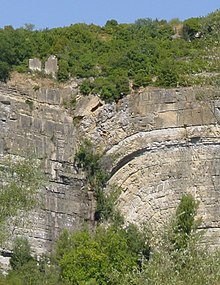Fault (geology)



In geology, a fault or dislocation describes a tectonically caused structural change in a rock formation. Older rocks, which have been tectonically stressed several times in the course of their geological history, usually show several generations of faults, of which only the most recent is undisturbed.
Terminology
A distinction can be made between disturbances in the broader sense and disturbances in the narrower sense . Disturbances in the broader sense include both the results of brittle and ductile deformation and consequently also include structures such as folds , flexures or ductile shear zones . The former are also subsumed under the term compressive dislocation . Disturbances in the narrower sense only include the results of fractional deformation, so-called faults or disjunctive dislocations .
For the latter context, the terms disruption and rejection are often used synonymously. In addition, in a somewhat fuzzy way, the interface created by the tectonic movement at a fault is also referred to as a fault. However, this is more correctly to be referred to as a fracture, fault or fault surface .
Sometimes the movement process itself, which, however, usually cannot be observed directly, is called a disorder .
Orders of magnitude
Faults can occur on various scales, starting with ductile shear zones, which are only visible in a thin section under the microscope, over centimeters to several meters measuring faults, folds and ductile shear zones on the scale of a handpiece or outcrop , up to fracture and shear zones that stretching for hundreds or even thousands of kilometers, such as the San Andreas Fault in California.
See also
literature
- Günter Möbus: Tectonics . German publishing house for basic industry, Leipzig 1989, ISBN 3-342-00403-7 .
- Donal M. Ragan: Structural Geology: An Introduction to Geometrical Techniques . Cambridge University Press, Cambridge 2009, ISBN 978-0-521-74583-3 .
- Friedrich Bender: Applied Geosciences, Volume I: Geological Survey, Structural Geology, Structural Science, Soil Science, Mineralogy, Petrography, Geochemistry, Paleontology, Marine Geology, Remote Sensing, Economic Geology . Thieme, Stuttgart 1981, ISBN 3-432-91011-8 .
- Hans Cloos: Conversations with the Earth . Gutenberg Book Guild, Frankfurt am Main 1947.
Individual evidence
- ↑ a b Vladimir Kotlyakov, Anna Komarova: Elsevier's Dictionary of Geography, in English, Russian, French, Spanish and German. Elsevier, 2006, ISBN 978-0-444-51042-6 , p. 195